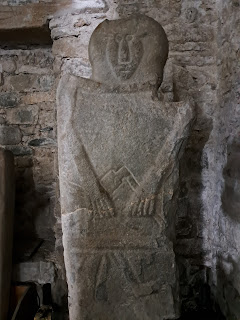Dai a ogni giornata la possibilità di essere la più bella della tua vita
(Give each day a chance to be the best day of your life)
- written outside B&B Il Gredo, in Filetto
The recently discovered Warrior of Sorano is a stele or statue menhir which is unusual in that it was remodelled at a later date, transformed into an image of an armed warrior with an inscription, now illegible. This particular stele was preserved because it had been reused in early medieval times as an architrave over a side door of the church of Santo Stefano in Sorano, facing upwards so that the carved pagan image would not be visible to people passing through the door. It was rediscovered during the restoration of the church in preparation for the celebration of the jubilee year 2000.
Pieve di Santo Stefano di Sorano
Mentioned by Sigeric, and therefore in existence before the year 1000, the church was rebuilt in the 11th to 12th century in the Lombard Romanesque style. The square tower was added later, possibly as a watchtower to guard over the nearby road - the Via Francigena, of course!
The entire construction is made of stones polished smooth and round by the river, joined with mortar and topped with a slate roof.
On the far side of the church from the road, behind the little cemetery, is a tourist information office with public washrooms, located on the site of a Roman mansio or roadhouse that was in use until the fall of the Roman Empire. Around it stand a number of stelae found in the area.
The name Filattiera comes from the Greek filakterion, to defend or protect, testifying to the Byzantine fortifications present on the site in the sixth and seventh centuries, during the wars between the Byzantine and Lombard empires. The medieval castle and church of San Giorgio replaced these on the hilltop, and the village grew around them.
After leaving Filattiera through an arch in the old town's defensive walls, the Via Francigena heads into the woods for a pleasant, shady walk toward Filetto, my destination for the day.
The vegetarian options on the menu were testaroli al pesto followed by vegetable and rice pies with salad. Testaroli are characteristic of Liguria and the Lunigiana area, and were actually a primitive form of bread, before humans discovered yeast and ovens: they are made from flour, olive oil and water, simply mixed, poured into a terracotta dish, and stacked over an open fire. They are now normally made using more modern means, but still taste as good - especially with pesto!
Click here for a modern-day recipe in English!
Filetto
The name Filetto also comes from the Greek filakterion, so it's no wonder I kept getting the two of them mixed up when planning my day! 😄 But fortunately I booked my room in the right place, Filetto, 18 kilometres down the road from Pontremoli. It also arose as a part of the Byzantine fortifications against the Lombard "barbarians"; the remains of the fortifications were incorporated into the walls of the medieval town built along the Via Francigena, with a pilgrim hospice in the woods, referred to in the documents as Selva Donica. Today its functions of accommodating and feeding pilgrims have been taken over by a couple of bed & breakfast establishments and a smattering of bars and restaurants!
 |
| Only half of the Pontremoli - Aulla stage today! |







































Bella tappa, bella giornata. Grazie per i tuoi racconti che ci permettono di essere lì con te anche se lontani e di seguire i tuoi sempre interessanti percorsi. Lunigiana tutta da scoprire e valorizzare e solo a piedi si apprezza veramente. Buon cammino! Mariella
ReplyDeleteE finalmente si mangia la verdura! Torta di erbe a pranzo e cena 😅
ReplyDelete